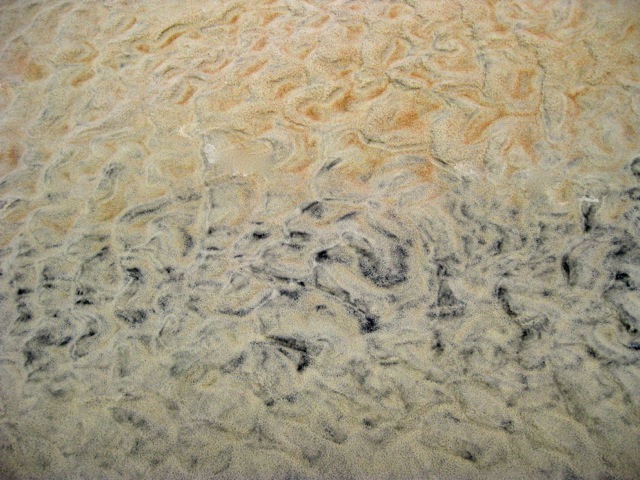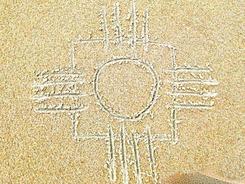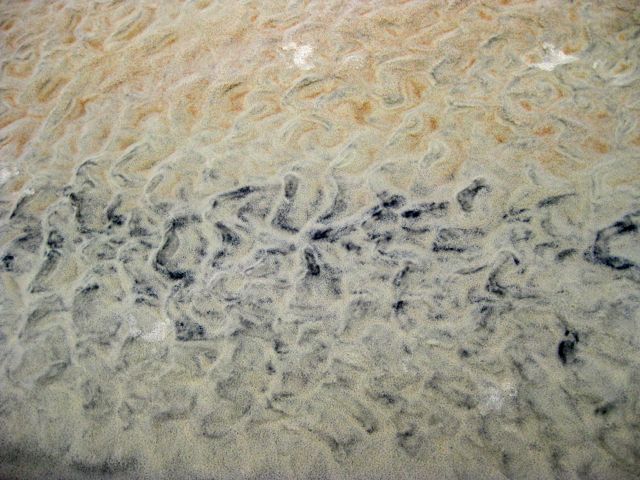Meet the Teachers
Florida Sandplay Therapy Association
SandSearch.org
Interview with Lucia Chambers, July 2012
By Bunnie Graham
Introduction
Lucia Chambers is a founding member of the Sandplay Therapists of America. She consults, teaches and assists in setting up study programs across the United States. She maintains a private practice in San Jose, California. She founded the Sandplay Therapy Institute and is one of the first two teachers in the series of eight weekend sessions. (See STI Training information.)
Lucia and I talked on the telephone on a summer afternoon in July 2012.
Experience with Sandplay Therapy
Bunnie (B): Lucia, the Florida Sandplay Therapy Association is grateful that you are bringing the Institute to Tampa in September. As a way of welcoming the Institute to Florida, we are interviewing each Institute teacher for our website, SandSearch, so the students can get to know something about the faculty. You are one of the first teachers and your interview today is also a first.
Lucia, as founder of The Institute, what is most important to you about teaching sandplay therapy?
Lucia (LC): The experience of it touches me all the time. Every time I show the slides or talk about a principle of it, a memory is touched. Sandplay Therapy operates from a place deeper than the persona or the brain. That's the place that is touched.
B: How does sandplay therapy work?
LC: I don't know. That is the mystery. The only thing that I do know is that when it happens it isn't left-brain; it operates within me and everyone everywhere. Sometimes we are separated from the mystery of life because of this left-brain dominant world. Sandplay nourishes souls, and in that experience there is a universal connection with something that affects everyone, that encourages a different way of being.
B: Is this what heals?
LC: I don't know. The psyche heals. “We” do not do it. IT does it. We do not know very well how to help that happen.
B: How do you act in the presence of this mystery?
LC: It has chosen me at that moment. My only choice is to give myself to it as much as I can. I just get out of the way.
Paradox
B: And that's hard! How do you teach that to students?
LC: Yes, teaching in words is left-brain and you have to have that for a structure. But that is not where sandplay lives. And so if talking about a structure can touch something in someone, that's what I would like to have happen. But sometimes it doesn't. And all the time it surprises us. This simple place is where we really struggle in sandplay with the whole paradox. We think we can learn it like another modality and do it. That's not it. How do we provide the opening without killing it? We must learn to live with dichotomy. Jung talks about holding the opposites: the Logos and Eros, the right- and left-brains, cognitive and intuitive aspects of life, until we reach some kind of forward motion. We have to hold them in balance; it is very hard.
B: Can everyone do it?
LC: Everyone has the possibility. Trying is the important part.
Teaching to Hold the Opposites
B: How can you teach people how to hold to the opposites?
LC: Teaching means that I have some words to use about it. I talk about Jungian theory. I even have a diagram of a psychological structure to talk about. That is how I get CEUs for my students. Then I wait for what happens. The visual images we show are extremely important. By our showing the pictures, the metaphorical comprehension goes right in and bypasses the words, which can get in the way. We have to use the structure of the words to provide the framework and then hang the images within that structure.
Time
B: You sound like a reluctant professor.
LC: Another paradox! It is embarrassing but we have to fit into the grid somehow or the experience that sandplay can provide may be lost. Before there was ISST, every therapist in California had little figures to put in the sand. Dora asked, “Do you think it is too late for them to understand about sandplay?” She knew already that the concept of depth was not being valued. If she could see it now: how we give a pill these days! There is a race about time, but clock-time is not the measure. In planting a seed, it takes a significant amount of time to produce the fruit and you cannot hurry it. Once my young son planted carrot seeds and got tired of waiting. He pulled one up to check on it. There was no carrot! Likewise, a seed might be planted and, grow or not, according to that person's psyche. I do not know how long it takes. One student in Florida said she read a book about sandplay 15 years ago and has been holding it in her mind this long. Dora also said that sometimes the behavior doesn't change for many months after we might expect because it grows in its own time and with its own mystery.
B: So with this growing process, when does it get through?
LC: I am not through. Are you through? You know when something has happened: but you don't know what it is and what it will do.
B: This mysterious method is a tough sell.
LC: This is a tough teach! But you must have faith in the right-brain. It is very tough if you believe that the words you say in a class will change everybody in the class. Because if it touches one person you are fortunate; and you will never know. You do not even know if they are the right seeds you are planting. You bring your own experience; you hold it, and then share whatever you can and let it go.
B: So we cannot get attached to the outcome?
LC: We each need to give ourselves to it. It is a paradox where the opposites cancel each other out. It is very funny and deadly serious at the same time. You must hold both sides at the same time. There might be a transformation...or not.
B: Holding the space means something like having a hovering presence?
LC: Being there. That's the selfish part of teaching because I get to go to that place. I have committed myself to go. It is my privilege.
Symbols
B: Are you the vehicle for this mystery?
LC: Perhaps you could say I'm a representative. Sometimes I choose a miniature at the beginning of a class. I go first and speak as the figure. I am always surprised because I reveal myself, and it is the first exercise in releasing persona energy into a symbolic place. And that is sometimes the first experience the students have of seeing that. Sometimes it's quite revealing. Once I picked a butterfly when I was very tired, and as I was talking, I heard myself say, “As a butterfly, I have such wonderful wings and I can fly away and get out of here.”
B: What happened then?
LC: I just owned it. I was in front of everybody dropping the persona and identifying the energies that are flying around all the time except we don't want to own them. It was my own fatigue and the demand of what I had to do. As an introvert, I was embarrassed; but now I just laugh. It is good for me!
Dora
B: Do you have any favorite Dora stories?
LC: I do not tell many Dora stories any more. She's a name. I have to stand on my own. I can't use her anymore; I cannot ask her to prop me up.
B: Are there ways you are different from her?
LC: We are all different from her and each other. She had the ability to be more extroverted; she did not hesitate to ask for what she needed. She connected with people who helped her develop and expose her ideas to the world. She was very gifted in terms of sitting down with somebody. People set up situations so they could have conversation and relationship and share with her. She was remarkable for her persona but also for the energy she carried. When I did a tray with her, she sat opposite me, on the other side of the sandtray. I was involved in the tray and when I would look up, her eyes went right into me.
B: You felt like she saw everything inside you?
LC: Yes, she was seeing all of me and receiving everything, but not evaluating me. She did not talk in terms of strong and weak but in terms of energy. I try to do this too. For instance, there might be threatening or loving energies, but we are not using evaluative terms like “good or bad.” She accepted all of it. In this collective culture everything is judged and graded as strong or weak, good or bad. The minute we do that we get caught in it and we are stuck. We are rigid in one situation and not able to be fluid like the complementary yin and yang symbol.
B: Do you work with a sense of having a mission?
LC: If sandplay is tainted or cheapened, shifted or changed it would be awful. We are all trying to be accepting of change but it's very challenging. I do not know what the world direction is taking now but somehow the action of the psyche will survive. That's the human species. How can we maintain our connection to the psyche in a world that doesn't seem to acknowledge soul any more? How do we fit into this new world as soulful individuals?
Personal Connection
B: How do you maintain your soulfulness?
LC: That is one of the things that motivated me to start the Institute. The opportunities to immerse oneself in this work are limited and we are so lucky here. Emails come from all over the world asking for soul—for meaning. I cannot send it out like that, but I do know that something happened at the last Institute in Minnesota where people gathered and they were touched and there is now a wish to continue some kind of ongoing gathering. It's the distance that makes this difficult. The turnout here in Florida is phenomenal and people seem to be starving for this work. Trudy and Patricia have sown seeds everywhere and now they are beginning to sprout in unexpected ways.
B: If you drew a map of sandplay, what would it look like?
LC: It's a world map. Something Dora did say, and I say it now, is that sandplay therapy is a universal language. You don't have to understand the words before you do it. Once I went to a large Japanese conference. By seeing slides of their cases, I could tell the client, the problem and the solution. It is mind-boggling! The human psyche is culturally neutral when we are born, and then our environment shapes it. But psyche can't be pigeonholed: try to do that and you lose it. The deep levels are beneath the new things and changing trends.
We have talked an hour and are right back where we started.
B: Yes, it is a mystery and we are privileged to be doing this work. Is it a circle?
LC: Perhaps it is a spiral, my symbol with Dora. This always happens; it always comes back to this mystery!
B: Thank you Lucia. It has been a privilege to talk to you today.
Fostering growth & healing through symbolic process




